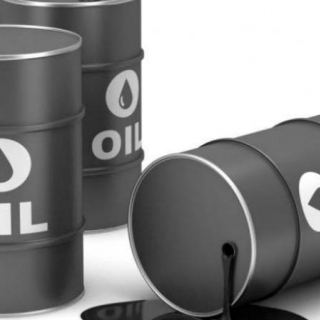


Oil prices held gains this week as traders grappled with President Donald Trump's threat to impose punitive tariffs on Russian energy buyers.
West Texas Intermediate crude oil prices were little changed on Thursday, but closed at a six-week high the day before. The US president said he would impose tariffs on Indian exports and penalties on its energy purchases from Russia starting August 1, the latest in a series of comments in which he expressed anger over the lack of a ceasefire in Ukraine.
While the market impact of a disruption in Indian purchases could be significant, as Moscow would have to find new buyers if it lost one of its biggest customers, the relatively calm price movement suggests there is little expectation that Trump will follow through for now.
This is the latest sign that the oil market is increasingly reacting only to significant supply disruptions. Although Trump has repeatedly threatened measures that could hurt production in producing countries, from Venezuela to Iran and Russia, since taking office, there has been no substantial impact on global supply so far, even when the US bombed Iran's nuclear facilities.
Indian oil refiners are seeking clarity from the government in New Delhi. A senior executive at a major oil refiner said his company would try to source more crude from the Middle East and Africa, and is seeking government guidance on how to do so.
"Finding a replacement for Russian crude in the global market will be difficult," Goldman Sachs analysts, including Yulia Zhestkova Grigsby, wrote in a report. "While the exact details of potential economic sanctions remain unclear, investors are focused on the risks of potential 100% tariffs on countries importing Russian oil."
Trump's threat came hours before the US issued its most sweeping Iran-related sanctions in seven years, targeting an international shipping network controlled by prominent oil trader Hossein Shamkhani, whose father is a senior adviser to Supreme Leader Ayatollah Ali Khamenei.
Although the designation marks the biggest escalation in action since Trump returned to office, US officials said they do not expect the restrictions to cause lasting disruption to global oil markets, noting that most of the oil sold by the network is destined for China.
Collectively, these actions are a reminder of the kind of headline-driven volatility oil traders currently face.
Trump has also imposed an August 1 deadline for countries to finalize trade deals with the US, with South Korea and the European Union recently reaching agreements.
These risks have made it difficult for some of the world's top physical traders to make money. Shell Plc CEO Wael Sawan said on Thursday that his company had adopted a risk-off approach to crude oil in the previous quarter due to greater volatility, echoing comments from other major oil company executives in recent weeks. (alg)
Source: Bloomberg
Oil prices were steady on Tuesday (October 7th) as investors assessed a smaller-than-expected OPEC+ production increase in November amid expectations of oversupply. Brent crude futures fell 9 cents, ...
Oil steadied after a two-day advance after OPEC+ agreed on a modest supply quota increase, with traders also parsing signals from lower-than-expected Saudi prices. West Texas Intermediate traded...
WTI crude oil futures climbed 1.3% to $61.7 per barrel on Monday after OPEC+ agreed to a smaller-than-expected production increase, easing fears of a major supply surge. The group, which includes Saud...
Oil prices rose more than 1% on Monday after OPEC+ only raised November production by 137,000 bpd, a smaller increase than would have affected the market. At 08:08 GMT, Brent rose 1.2% to $65.33 per b...
OPEC+ is once again playing it cautiously. For the second consecutive month, the world's largest oil producer group only increased supply by 137,000 barrels per day—a figure significantly lower than m...
European stock markets edged mostly lower on Tuesday, as investors kept tabs on ongoing political turbulence in France and the United States that threatened to dampen enthusiasm around artificial intelligence dealmaking. The pan-European Stoxx 600...
Silver traded around $48.10 per ounce, retreating from the multi-year high touched on October 6th amid profit-taking as a firmer yield backdrop raised the metal's opportunity cost. The Treasury curve ticked up, making a non-yielding asset less...
Systematic hedge funds have lost money every day since October began, according to a Goldman Sachs client note. These speculators, whose algorithms ride market trends until they peter out and who use market signals rather than views on the...
 Asian stocks surged to new highs, led by Japan's Nikkei 225, which surged more than 4% following the election of pro-stimulus lawmaker Sanae...
Asian stocks surged to new highs, led by Japan's Nikkei 225, which surged more than 4% following the election of pro-stimulus lawmaker Sanae...
 The S&P 500 and Nasdaq Composite closed at record highs on Monday, spurred by optimism about increased mergers and acquisitions activity after...
The S&P 500 and Nasdaq Composite closed at record highs on Monday, spurred by optimism about increased mergers and acquisitions activity after...
 Hamas officials were in Egypt on Monday (October 6th) ahead of talks with Israel that the US hopes will lead to an end to the war in Gaza and the...
Hamas officials were in Egypt on Monday (October 6th) ahead of talks with Israel that the US hopes will lead to an end to the war in Gaza and the...
 Euro Area Stock MarketEuropean stocks closed mostly lower on Monday as fresh political turmoil in France rekindled concerns of fiscal instability...
Euro Area Stock MarketEuropean stocks closed mostly lower on Monday as fresh political turmoil in France rekindled concerns of fiscal instability...